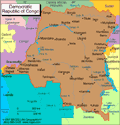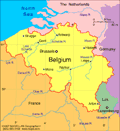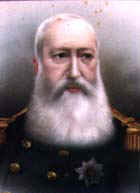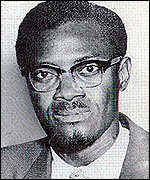| Want to send this page or a link to a
friend? Click on mail at the top of this window. |
| Posted September 22, 2002 |
| Unsavory Colonial Behavior in the Congo |
| Will Be Tackled by a New Study |
PARIS - No less than other European powers, Belgium proclaimed its colonial mission to
be that of spreading civilization. But while Britain and France, say, had global empires,
Belgium's attention was focused overwhelmingly on the vast, resource-rich Central African
territory of Congo, 75 times larger than Belgium itself. The deal was implicit: in
exchange for extracting immense wealth from its colony, Belgium offered schools, roads,
Christianity and, yes, civilization.
| Yet Belgium's pride in its colonial past has always been
shadowed by a darker history, one marked by two decades of perhaps the cruelest rule ever
inflicted on a colonized people and, half-century later, by a violent intervention in
Congolese politics after the country's independence in 1960. This history, long buried,
neither taught in schools nor mentioned in public, is now beginning to surface. In
February, Belgium admitted participating in the 1961 assassination of Patrice Lumumba,
Congo's first Prime Minister, and apologized for it. The motivation for the crime was to
avoid losing control over Congo's |
 |
|
 |
Congo's map |
|
Belgium's map |
|
| resources, but Belgium steadfastly denied any involvement until new
evidence collected by a parliamentary commission last year confirmed the direct role of
Belgian agents in carrying and covering up the murder. |
| Now fresh light may be thrown on an earlier, still darker, period of
Belgium's reign over Congo. In anticipation of a major exhibition scheduled for fall 2004,
the Royal Museum for Central Africa in Tervuren, near Brussels, is sponsoring the first
far-reaching review of Belgium's colonial past, including the period from 1885 to 1908
when, as the personal property of King Leopold II, the Congo Free State is believed to
have suffered violence and exploitation that cost millions of lives.
Guido Gryseels, the director of the
government-owned museum, says the purpose of the study is not to pass judgment but to
provide information about a neglected past. In addition, he says, the study will address
more than just the political aspects of colonialism. It will also look at the period
through the prisms of Central Africa's history, anthropology, zoology, disciplines that
form part of the museum's permanent scientific mission. |
 |
|
 |
King Leopold II of Belgium, the
self-declared proprietor of Congo from 1885 to 1908. |
|
Patrice Lumumba,
first Prime Minister of Congo, in 1960; deposed that same exact year and, brutally
assassinated in 1961. |
|
Yet the initiative is daring, since it raises the broader question of a country's
continuing responsibility for unsavory actions carried out in its name generations or even
generations earlier. These range from promotion of the slave trade and annexation of
territories to colonial repression and ransacking of natural resources. Further, while the
study is not subject to Belgian government control, it will be financed by the taxpayer,
which makes intense public debate of its findings even more likely.
So far, no other former colonial power has shown an appetite for looking back with a
critical eye, even though the colonial records of, say, the British India, the French in
Algeria, the Dutch in Indonesia and the Portuguese in Angola all contain examples of human
rights abuses and excessive use of force. Interestingly, Mr. Gryseels said he had received
strong expressions of support for his project from foreign historians and social
scientists.
Maria Misra, a
lecturer in modern history at Oxford University, believes that Britain, should follow
Belgium's example. "The point of cataloging Britain's imperial crimes is not to trash
our forefathers," she wrote in The Guardian of London, "but to remind rulers
that even the best-run empires are cruel and violent, not just the Belgian Congo.
Overwhelming power, combined with boundless superiority, will produce atrocities - even
among the well-intentioned.
The strong emotional attachment of some former colonial administrators to prized former
colonies, however, can pose a problem. "Every time Belgian ex-colonials hear
criticism of what happened under King Leopold, they see it as a criticism of colonialism
in general," Mr. Gryseels explains. "A lot of Belgians worked hard in developing
the infrastructure, building roads, organized school systems, and they feel they did a
good job and it is very unfair that the whole thing is being criticized in a very
one-sided way."
A case against King Leopold, though, was already being made a century ago. In 1899,
Joseph Conrad published "Heart of Darkness," in which he expressed the horrors
of Congo. In 1904, a British shipping agent, Edmund Morel, formed the Congo Reform
Association, which publicized the human toll of Leopold's rule. Finally, under British
pressure, Leopold sold Congo to Belgium in 1908. In 1919, a Belgian commission estimated
that Congo's population was half what it was in 1879.
But all this was expurgated from Belgium's official memory. "My generation was
brought up with the view that Belgium brought civilization to Congo, that we did nothing
but good out there," said Mr. Gryseels, 49, who attended high school in the late
1960's. "I don't think that during my entire education I ever heard a critical word
about our colonial past."
By the time he took charge of the museum a year ago, however, attitudes were changing.
Belgian intellectuals were conversant with a four-volume account of Leopold's Congo by the
respected Belgian historian Jules Marchal as well as with other new histories of Europe's
appropriation of Africa. But no book had the impact of Adam Hochschild's King Leopold's
Ghost: A Story of Greed, Terror and Heroism in Colonial Africa" (Houghton Mifflin,
1988), which appeared in translation in Belgium in 1999.
In it, Mr. Hochschild describes how, along with the uncounted thousands who died of
disease and famine, many Congolese were killed by Leopold's agents for failing to meet
production quotas for ivory and rubber, the territory's principal sources of wealth before
its diamonds, copper and zinc were discovered. Mr. Hochschild estimates the total death
toil during the Leopold period at 10 million.
| Leopold himself never visited Congo, but it fed him the
income to build palaces, monuments and museums and to buy expensive clothes and villas for
his teenage mistresses. In 1897, he built the Museum of the Congo - later the Museum of
the Belgian Congo, today the Royal Museum for Central Africa - to house an exhibition
devoted to animals, plants, ethnographical objects, sculptures and scenes of African life.
The show's popularity led to the building's conversion into a permanent museum linked to
an institute for scientific research.
"Today we have the very fine
collections, but the museum has remained almost unchanged for over 40 years," Mr.
Gryseels said, |
|
|
|
One of King Leopold II's many grandiose
monuments |
|
|
| "so it needs all sorts of change, first of all the message, which is
still very colonial and provides the Belgian view of Africa before 1960 and is not very
much related to the Africa of today." At the museum's entrance, for instance, a large
statue of a white colonial and two kneeling Africans still stands, accompanied by the
inscription, "Belgium brings civilization to the Congo." |
As part of a reorganization of the museum in preparation for the 2004 exhibition, Mr.
Gryseels decided to take a fresh look at Belgium's colonial past. The study, which begins
this fall, will be carried out by a scientific commission led by the Belgian historian
Jean-Luc Vellut and will address Belgium's entire colonial past, not just the Leopold
period. To ensure objectivity, working groups will also include American and African
scholars.
Now, Mr. Gryseels acknowledged, the museum is ill prepared to address the issue raised
by Mr. Hochschild and other recent authors. "When you visit our museum, you don't
find any information about the allegations made in these books," he said. "So we
thought it was important to present the different views of historians on that period and
provide scientific information so that a visitor can make up his own mind."
He does not expect the study and exhibition to lead to a fresh apology to Congo,
however. "A lot of very positive things happened during the real period of
colonization after 1908," he said. "Also, I don't think one should look at the
past with the moral standards of today. After all, early in the last century, children of
6 or 7 were working 17 hours a day in Belgian factories. We should look at it with the
standards of those periods."
But, Mr. Gryseels was asked, was he shocked when he read Mr. Hochschild's book?
"Yes, I was," he said softly. "Obviously, it hits pretty hard.
Especially since I am from a generation that was brought up with a very positive and
flattering view of our colonial activities. I am from a generation that sold calendars and
New Year's cards to help missionaries in Central Africa. And when you read all these
revelations, they're pretty hard hitting."
Reprinted from The New Times, Arts & Ideas, of September 21, 2002. The photographs
accompanying this column are not of The New York Times.
Copyright 2002 The New York Times Company
| Wehaitians.com, the scholarly journal of
democracy and human rights |




